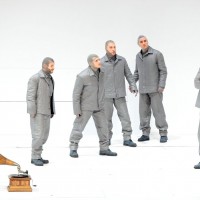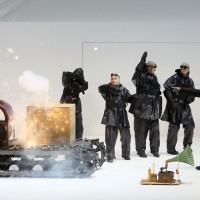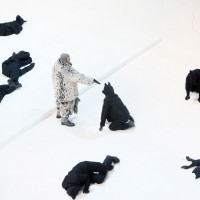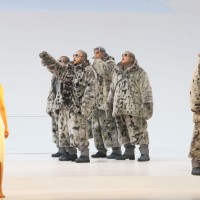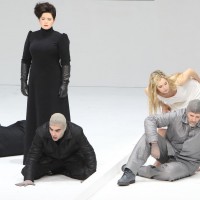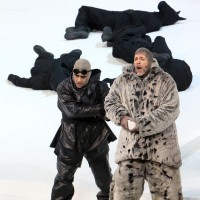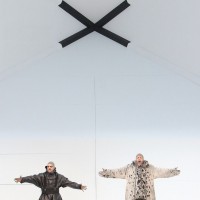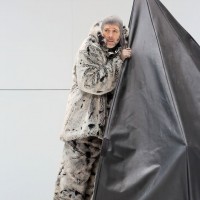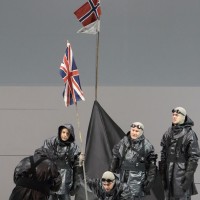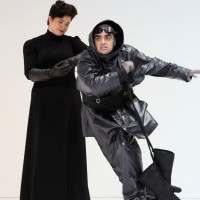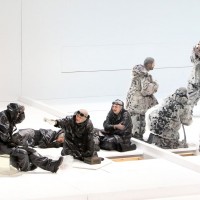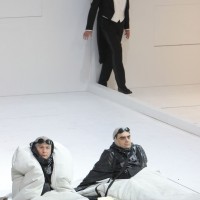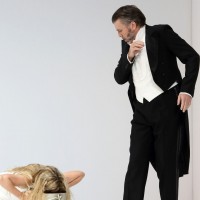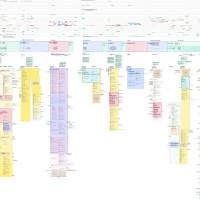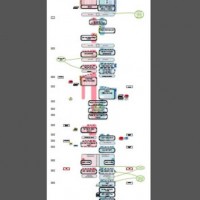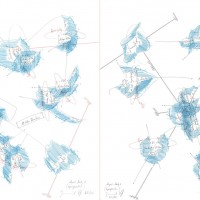SOUTH POLE in Munich – Opera – Review and fotos
SOUTH POLE in Munich – Review and fotos
By Henning Høholt, fotos Wilfried Hósl, Bayerisches Staatsoper
.

South Pole Miroslav Srnka (left) and Tom Holloway, foto: Wilfried Hósl, Bayerisches Staatsoper.
MUNICH/GERMANY: Kulturkompasset were privileged to attend the world premiere of the opera South Pole by Miroslav Srnka to libretto by Tom Holloway 31. January in Munich.
To get the possibility to follow the two famous opera stars Thomas Hampson (baryton) as Roald Amundsen and Rolando Villazon (tenor) as Robert Falcon Scott, was a great pleasure.
– –
The exiting history about the two South Pole explorers Roald Amundsen and Robert Falcon Scott in 1911, had now found its way to the opera world, on a libretto, based on many facts, formed in a fiction way by Tom Holloway, with an interesting musical frame by the composer Mirislav Senka, who has been forming a composition for 12 singers, all outstanding soloists, inclusive two world stars,- the famouse baryton Thomas Hampson as Roald Amundsen, who well prepared and with a large exploration experience, with his group, (of 5 barytons), reached the South Pole first at 14. November, and the contrasting group led by another opera world star, the world famouse tenor, Rolando Villain as Robert Falcon Scott at the head of his group (of 5 tenors) of explorers
.
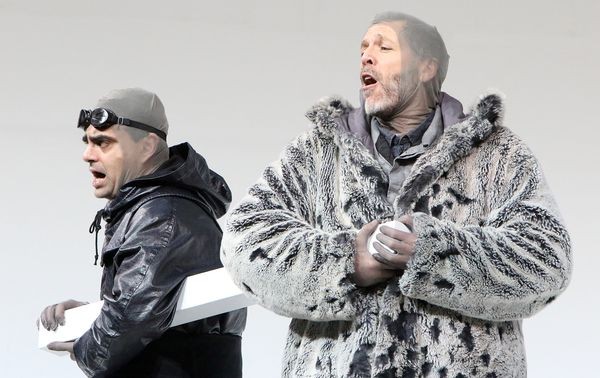
South Pole, Rolando Villazon (left) as Robert Falcon Scott, and Thomas Hampson as Roald Amundsen. Foto Wilfried Hósl, Bayerisches Staatsoper.
Review: Henning Høholt, aplaus photos Henning Høholt
MUNICH/GERMANY: The exiting history about the two South Pole explorers Roald Amundsen and Robert Falcon Scott.
SOUTH POLE expedition in 1911, has now found its way to the opera world, on a libretto, based on many facts, formed in a fiction way by Tom Holloway, with an interesting musical frame by the composer Mirislav Senka, who has been forming a composition for 12 singers, all outstanding soloists, inclusive two world stars,- the famouse baryton Thomas Hampson as Roald Amundsen, who well prepared and with a large exploration experience, with his group, (of 5 barytons), reached the South Pole first at 14. November, and the contrasting group led by another opera world star, the world famouse tenor, Rolando Villazon at the head of his group (of 5 tenors) of explorers.
The composer call his opera “A double opera in two parts”
Interesting to hear and see how these two usually classical operasingers managed to use their brilliant singing talents in a demanding contemporary musical composition, with very many difficult passages and parts, a lot of demanding high tunes, where the audience specially loved to enjoy mr. Villazons well knovn top tunes, which , during the way, reminded me of his famouse many high C’s in the Donizetti opera “Daughter of the Regimen”t. But in this connection with a well developed avanciert contemporary sound frame around him, where also the composer has made his high top tunes much longer than usual. Thanks to the brilliant musicality of the conductor Kirill Petrenko, and his first class collaboration with the singers, it became a success.
During the musical developement i found my self finding links to ideas from other composers John Adams repetitive minimalisme, and to Benjamin Britten, for me specially from a part in Peter Grimes.
The composer, Miroslav Srnka, has build up his opera well planned, organised, and formed with a big opening part with all ten members of the two explorer groups, spite, not together, as they are both groups at Antarktis at the same time, but never together at the same time atvthe same place during the expedition. Therefore split up, like in each their camp, on each their side of the stage.
The opera is elegantly opened by a morse message, before they make a vocally large ensemble, where the tenor and baryton groups in a cantate way are forming and developing the musically material well.
LARGE MUSICALLY VARIATIONS
This opera has big variations, from very powerfull parts to intime pianissimo parts with only one or a few singers. One of these parts, a small quartet with tenor, baryton, soprano and mezzo was among the musically highlights.
During the way the good cast shows a lot of variations of their different personalityes, such as the beautiful “duet” where Lawrence Oates, – Dean Power, from the Scott group, and Hjalmar Johansen – Tim Kuypers, from the Amundsen group are writing each their letter to their mothers
.
Also a big powerfull ensemble, now inclusive the two female voices, mrs Kathleen Scott – Tara Erraught and the Landlady of mr. Amundsen – Mojca Erdmann, splendid ends the first act.
These two female figures are as a good fiction enclosed in the history.
It gives a variation in the sound to have two good female voices, soprano and mezzo, first to give the variation musically, but also through the libretto to give the history a background around the guys “on tour”.
MUSICALLY INTERESTING DETAILS
An interesting detail is the composers elegantly use of the idea to let the singers keeping their tune line, when they are singing it, as it is, but then letting the orchestral line vibrating a slightly bit around this vocal line, under and over it.
This idea gives extraordinary feelings in the sound, that i am not familar with from before.
For the singers it must be very demanding to keep their master tune so safe, when they hear that the orchestral line is mowing slightly up and down around their tune.
The singers managed to make it, successfully- bravo. – Well, this is an effect, but a deliciouse idea of developing musically ideas.
MORSE SIGNALS
The whole opera ends in the same way as the opening with a morse message. In the beginning Scott is being very surprised, as we know, as it originally was Amundsens plan to go to the North Pole, a plan he changed, and desided to go to the South Pole in stead.
Before Roald Amundsen, now well at home in Norway, tells the sad message that Scott and his crew died during the returning part af their exspedition at the arctic before reaching home.
GOOD DETAILS
During the performance many good details appears.
In the opening part, both groups are celebrating that they are ready to start the expeditions, first playing at each their piano, then on each their old fashion grammohone a la “His Masters Voice”
Where the Scott group enjoys the tenor Enrico Caruso singing the Flower aria from Bizets Carmen and the famouse norwegian soprano Borghild Bryhn-Langaard. In these parts the orchestre is woven in to the orchestre partitur.
In happy parts of the opera we enjoy the happines in both of the groups. Mr. Villazon as we know him well from other classical operas are brilliant in his dramatic, and happy visuality.
On the way back from South Pole, Johansen see birds and is very happy about it, and shows his happynes well visually.
Good actors
.
In some of the music i feel connections to other operas.
Up on arriving and leaving the operahouse the audience got the right sound feeling of how hard the weather around the South Pole could sound. Due to a 12 min sound installation.
Unfortunately, the composer has not in any way managed to bring this feeling in on stage, absolutely not in the sound.
Neither has regisseur or the scenographer managed to give us any feeling if that. This is a big minus for the production.
Many times the singers on the text are mentioning the bad weather, the snow, ice, but the regi and scenography dont cats it at all
example, the patient’s hypertension or depression. How does cialis work? then or now?”.
.
Therefore these two importent part of a demanding large musically work, didnt get any help at all from the regi or scenography.
Furthermore, and in fact, i see that even more seriouse. At the South Pole, when it is clear weather there is perspective, at this production there is no perspective at all, this stops and spoil the visual experience of the entire production.
At a modern theatre, this could have been made so beautifully and have given this production the little extra lift, that its music and the entire history had deserved.
It don’t help, three times to let members of the Amundsen group falling down in a gletcher, when we dont have any feeling of wild icy nature, or even just an open nature around them. BUH.
The scenography looked like a cold hospital interior in stage with two entrances to the left and three to the right, and some (two) verical openings on the back wall, – for the sleidedogs for Amundsens group and ponys for Scotts group. It looked like office windows in the hospital.
Sound from the outside sound culisse could have been helping a lot. And some snow and wind.
The light designer helped a few times giving a feeling of sunshine, that worked well.
I have the feeling that this opera could go in to the history of music as a renewing.
All photos by Wilfried Hósl:
- Gallery of Photos from the world premiere of the opera South Pole by Miroslav Srnka (music) and Tom Holloway (libretto), Photos Bayerisches Staatsoper.
- The Amundsen group listening to Solveigs Song by edvard Grieg, sung by the norwegian soprano Borghild Bryhn-Langaard
- Rolando Villazon as Robert Falcon Scott
- Shooting the dogs.
- The Roald Amundsen Group, and (left) Mojca Erdmann as Amundsens Landlady. All Photos from the performance Wilfried Hosl.
- Standing Tara Erraught as mr. Kathleen Scott, (left), and laying behind Mojca Erdmann as Amundsens Landlady, In front left Rolando Villazon, and Thomas Hampson as Amundsen (right)
- left Rolando Villazon, and Thomas Hampson as Amundsen (right)
- (left) Rolando Villazon, and Thomas Hampson as Amundsen (right)
- The explorer group of Robert Falcon Scott has reached the South Pole.
- (left) Mojca Erdmann as Landlady for Amundsen and Thomas Hampson as Amundsen (right)
- Diagramscetch from Miroslav Srnka for his Opera South Pole
- Diagramscetch from Miroslav Srnka for his Opera South Pole
- Diagramscetch from Miroslav Srnka for his Opera South Pole
In this following up we are presenting a long line of photos from the premiere of South Pole, as we hope this will be of pleasure to our readers to get better acquainted with this contemporary opera.
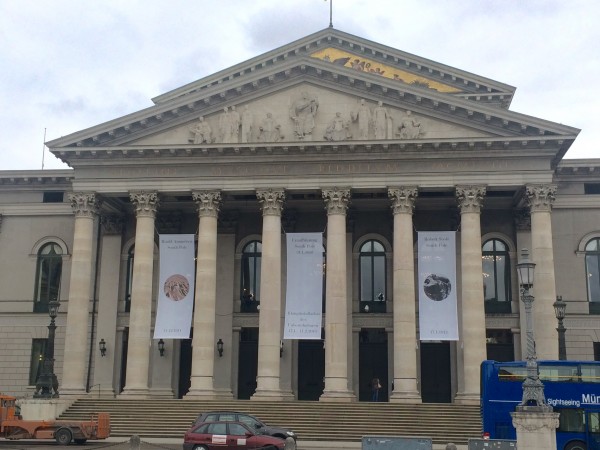
Bayerisches Staatsoper, 31. January 2016. Foto Tomas Bagackas
www.germany.travel www.facebook.com/germany.scandinavia www.germany.travel/hotspots
Bayerisches Staatsoper, München
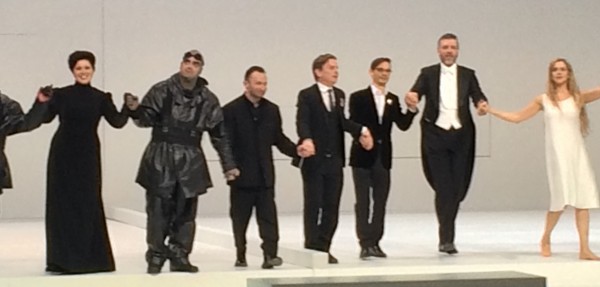
Applause after world premiere of the opera SOUTH POLE by Miroslav Senka at Bayerisches Stastaoper, Munich. from left: Rolando Villazon (Scott), Kirill Petrenko, conductor Miroslav Senka, composer, Tom Holloway, libretto, Thomas Hampson, (Amundsen), Mojca Erdmann, Landlady for Amundsen. Foto: Henning Høholt


